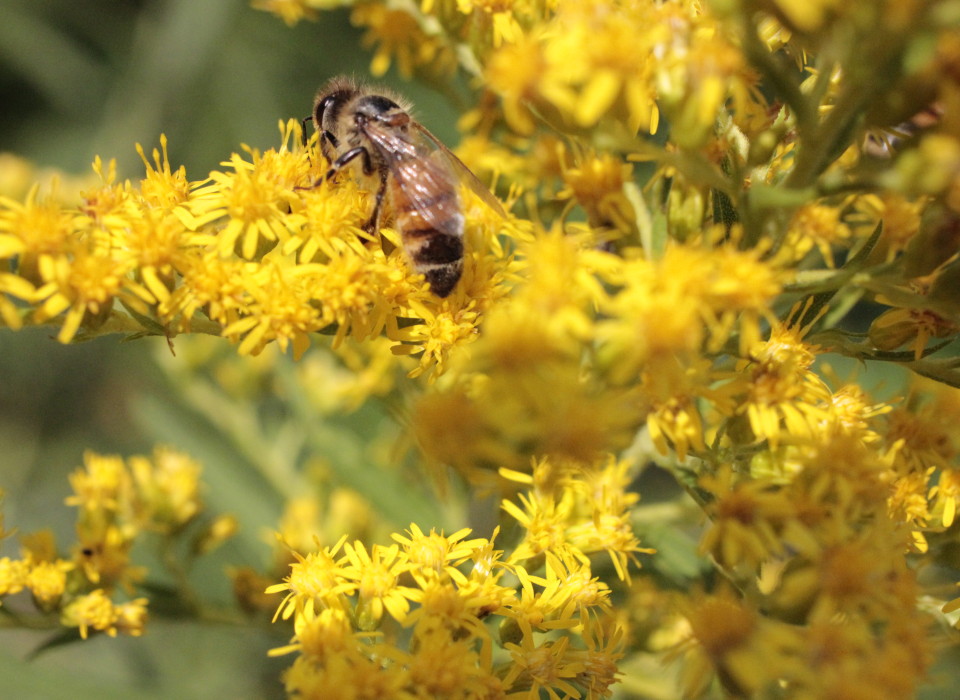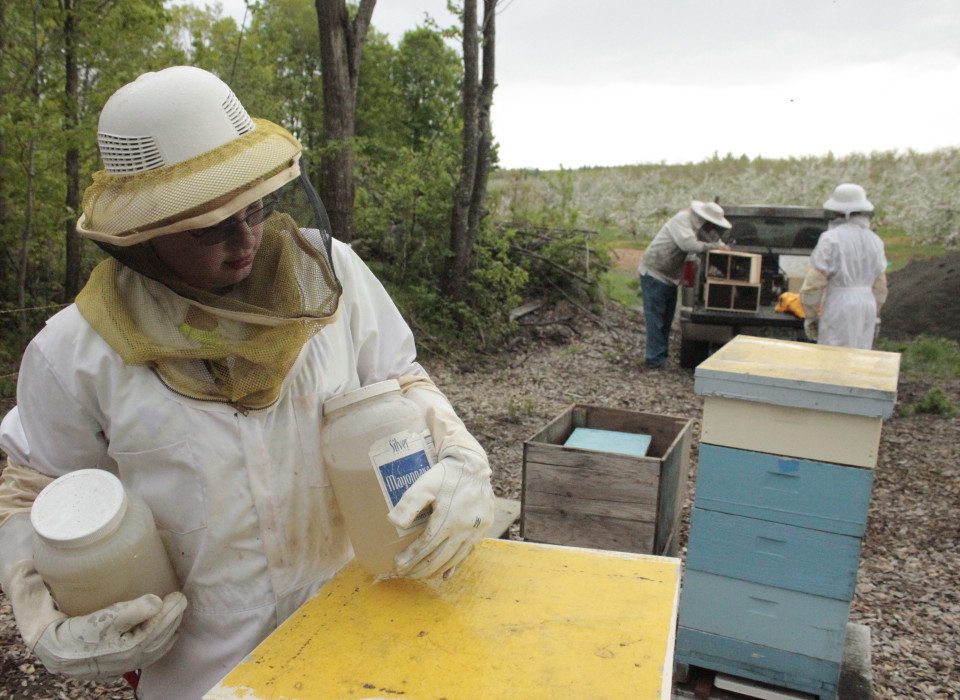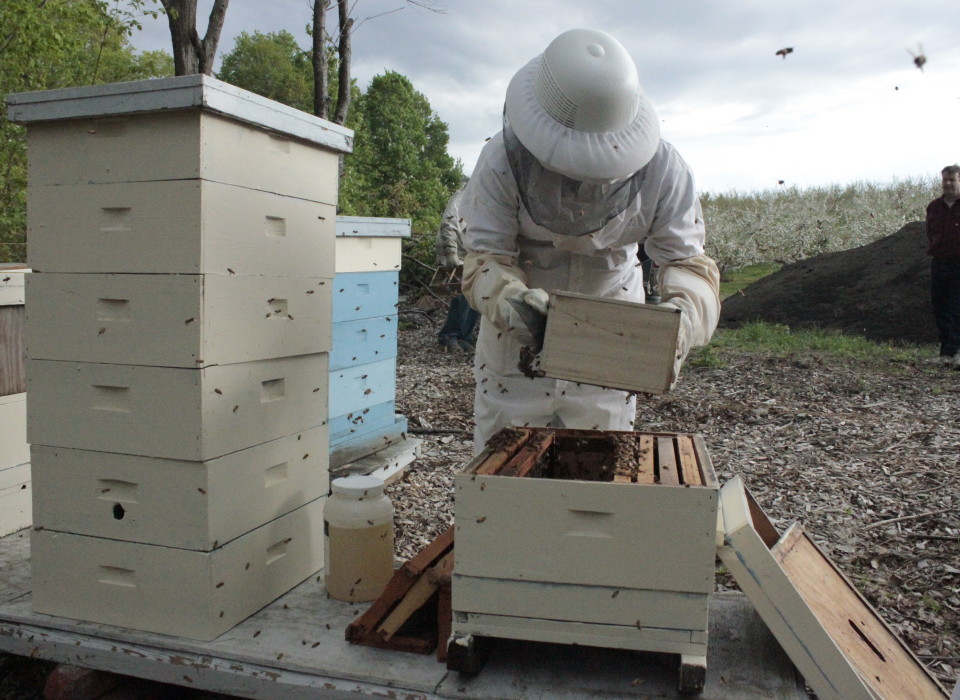Although the honey bee is typically what comes to mind when thinking about pollinators, there are lots of native insects doing their part to produce our food as well. Bumble bees, carpenter bees, leaf cutter bees, and mason bees are just some of New Hampshire’s native bees. Distinct from social bees like the honey bee, carpenter and mason bees are two examples of solitary bees that don’t form colonies. Instead, they form individual nests utilizing wood or mud and water respectively. UNH Cooperative Extension Field Specialist George Hamilton works extensively with Hillsborough County growers. “They rely on [native pollinators] more than they even know.” Hamilton said. Specifically, Hamilton says, the squash bee is one of the, “unsung and unseen heroes” pollinating cucurbits like squash and pumpkins. UNH assistant professor and researcher Sandra Rehan estimates that there could be up to 250 bee species in New Hampshire. She and a team at the New Hampshire Agricultural Experiment Station at UNH are conducting research monitoring native bee populations and their habitat with hopes of informing farmers and policy makers with how best to promote health and productivity of native pollinators. There they have constructed a ‘Bee Hotel’ with different features to attract specific bees. You will also find butterflies, moths, beetles, and even flies pollinating crops here in New Hampshire.
Despite the importance of native pollinators, the honey bee is still the workhorse of pollination for agriculture. Alden Marshall runs B-Line Apiaries out of Hudson and keeps around 200 hives at area farms including Brookdale Fruit Farm in Hollis, Wilson Farm in Litchfield, and Holland Farm CSA in Milford. Each year he brings anywhere from 800-900 three-pound packages of bees up from Georgia for both starter and replacement hives for his customers as well as his own hives. “I had to replace 50 percent of my hives this year,” Marshall said. There are lots of factors that contribute to bee health and survival rates, but the biggest factor in the large number of hives lost this year was starvation according to Marshall. “They need to generate a certain amount of heat in the hives,” he said, “and that heat comes from calories.” If, as was the case this year, there is a prolonged winter then the bees can run out of food and starve to death.
One factor that is often cited for bee population decline is pesticide use, but, “Pesticide is not the problem it used to be.” Marshall said. Most farmers know the importance of bees to their success and therefore work diligently to protect them through Integrated Pest Management (IPM). Chuck Souther of Apple Hill Farm in Concord is always thinking about the bigger picture. “The whole concept of the practice [of IPM] is knowledge.” Souther said, “Knowing intimately what is going on in the orchard.” Souther uses trapping to monitor pests in his orchard and relies on the right tool for the right job. Years ago Souther had Alan Eaton, Extension Specialist and IPM Coordinator with UNH, release a predator to the tarnished plant bug in the orchard and hasn’t had a problem with them since. Sometimes, however, the appropriate response is spraying. “Techniques we might use would include choice of materials and time of application, both time during the year and time of the day. Time of year is critical.” Souther said. Knowing when bees are most and least active allows farmers to plan their managment strategies apropriately.
In addition to minimizing the risk to bees through IPM techniques there are ways for farmers to promote larger and healthier bee populations. Marshall says, “Bees need a diversified diet of a variety of flowers to feed on.” Bees need sugar from nectar and protein from pollen to survive. “Every type of flower has a different nutritional makeup.” Marshall continued. Souther has wildflower plantings for native bees and is planning on adding more. These wildflower plots give bees a steady but varied source of food. He also provides nesting sites for specific native bees like bumble bees and mason bees. Providing the proper food sources and habitat for pollinators is another example of using knowledge to benefit the farmer, the environment, and wildlife.
The demand for pollinator and beekeeping education is rising as demonstrated by the number of classes and programs available across the state. Marshall said there were 125 people enrolled in classes through the Merrimack Valley Beekeepers Association in Hudson this year. So many, in fact, that they had to turn people away. The month of May was filled with workshops from the Xerces Society, an organization devoted to the conservation of invertabrates and their habitat, at various farms across the state. These workshops focused on installing native wildflower plots for native pollinators as well as IPM strategy.
For more than 15 years, The Merrimack Valley Middle School Bee Club in Penacook (no relation to the Merrimack Valley Beekeepers Association) has introduced young people to and educated them on beekeeping. Taking students with an interest in the field and providing them with the knowledge of not only how to keep bees but why beekeeping is so important. “The original mission of the club was to get young people interested in bees and bring wild bees back to New Hampshire,” said Larry Boucher, the advisor to the club and former MVMS teacher. The group used to encourage swarming, which is when part of the colony splits from the rest of the hive taking the original queen with them to start a new colony, but, with the extremely low survival rates of these swarms, now focus on the survival rate of their primary hives and on IPM techniques to prevent mite infestations in those hives. That means that the latter part of their original mission has abated but the degree to which research and education in the classroom is utilized has increased. To address the mite problem, Boucher said, “The Club is going to a new level this year. We have a master beekeeper from Eastern Apiculture Society who has volunteered to monitor mite counts, which the students already know how to do but she is going to do it on a scientific basis, and if they reach medication threshold she will medicate.” The Club will have hives at Apple Hill Farm, Marshall Pumpkin Farm in Boscawen, and Carter Hill Orchard in Concord. The hives at Apple Hill will be monitored and medicated as needed but the other hives will just be monitored. This will give The Club an opportunity to compare survival rates of the treated hives versus the untreated hives and have a classroom-like experience out in the field.
Before the students are allowed to participate in the field work of actually maintaining a hive they must get a certificate from the ‘Bee School.’ The school consists of 8 classes where students learn everything from what is pollination and how does it happen to the entomology of a bee and the division of labor inside the colony. The students are required to do computer based research and create presentations demonstrating their knowledge in order to pass the school. “That’s their life, that’s the way they learn. They find out all kinds of stuff that, if I told them, wouldn’t fit for them,” Boucher said. The ‘Bee School’ gives students a foundation for growing their knowledge in apiculture because as Boucher says, “This is one of those deals where you’re always learning.”





Pingback: All Abuzz About The Perennial Pollinator Garden - Studley's Flower Gardens | Flowers, Garden Center and Landscaping